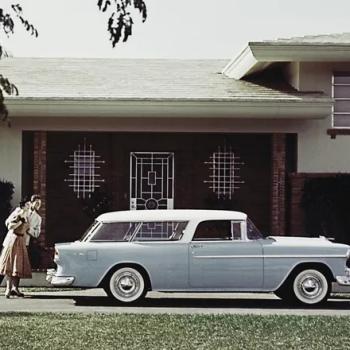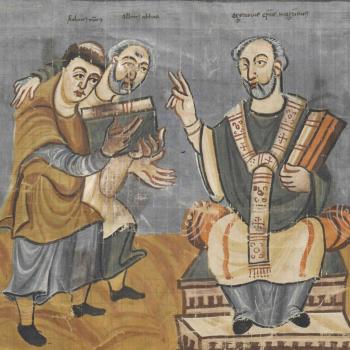So much has been written over the past few days about Billy Graham, who really does fit the description of a world-historical figure. I want here to address one sidelight on his work that I came across in research I did some years back on the Cold War era in the US. Although it certainly does not diminish his achievement, I want to stress how absolutely his ministry in the 1950s was rooted in the apocalyptic mindset of the peak Cold War era, in hard-line anti-Communist activism, and particularly in nuclear war fears. Those fears and dangers were very realistic, and should never be dismissed with words like “nuclear paranoia.” This element goes far to explaining his mass appeal through the 1950s and beyond.
I was looking at the anti-Communist movement in Pennsylvania. As part of that, I explored Graham’s historic 1952 crusade in Pittsburgh, which was then a primary battlefield of anti-Red campaigning, as well as constant preparations for civil defense. This Pennsylvania context needs some explanation. Though all the mainstream denominations were firmly anti-Communist, the most determined Protestant militancy came from conservative evangelicals and fundamentalists. Such groups framed the Communist menace as only one component of a much larger threat to religion posed by modernism in society, and particularly in the churches.
That view was held by one extremely important family, namely the Pews, who were so central to the state’s Republican politics. In the Cold War years, the family’s main representative was Philadelphia’s J. Howard Pew, who served as president of Sun Oil from 1912 to 1947, and was subsequently chairman of the board. Many of the family’s donations went to support explicitly religious causes.
The main target of Pew’s concern was the National Council of Churches (formed in 1950 from the older Federal Council), which he saw as a hotbed of liberalism indistinguishable from Stalinism. Responding to an approach from evangelical Protestants of several denominations, in 1956 Pew pledged $150,000 a year to fund a new mass circulation magazine, Christianity Today, to counter the “many so-called Christian papers [which] are but a device whereby editors can wear the livery of the church, and do the work of Socialists.” The relationship between Christianity Today and the Pews was long and cordial, to the extent that one prospective publisher suggested moving its offices onto the Pew family property in Ardmore, PA.
The clergy sponsoring Christianity Today were led by L. Nelson Bell, whose rightist political attitudes had been hardened by the collapse of the Christian missionary endeavor in China following the 1949 revolution. (That traumatic loss of China often motivated evangelicals through these years). Bell’s daughter Ruth grew up in China, and of course later married Graham. In turn, Billy Graham, “came to love [Pew] as almost a father.”
Though in later years Graham was known as a moderating voice within the evangelical movement, his missions of the 1950s were more overtly apocalyptic than those of later years, and as for Catholic preachers of the time, the total evil of Communism was taken for granted. In his famous 1949 crusade in Los Angeles, Graham had proclaimed that “Communism has decided against God, against Christ, against the Bible, and against all religion. … Communism is a religion that is inspired, directed and motivated by the Devil himself, who has declared war against Almighty God.” Or this from 1953: “Either Communism must die, or Christianity must die, because it is actually a battle between Christ and Anti-Christ.”
His Pittsburgh crusade of 1952 coincided with the public panic over so-called “hell-bombs” – hydrogen bombs – and of nuclear warfare more generally. (The first full hydrogen bomb test would occur in November 1952, but the concept had been widely discussed for some years, and there had been several partial tests). Graham consistently presented world-events in this eschatological framework. He declared that “All of the trouble with Russia began in the Garden of Eden.” Only a religious revival could prevent what was ultimately a spiritual rather than a political menace: “Unless this country has a revival of both morals and religion, it can’t survive the onslaught of Communism.”
Graham represented the apocalyptic strain in the evangelical approach to Communism, the diabolical inspiration of which was proved by the destruction of Christian missions in China and elsewhere. The imminence of the end times might well be signaled by historic events like the recent return of the Jews to the land of Israel – and of course, the development of larger and larger nuclear weapons. If you did not recognize that these were the end times, you weren’t reading the headlines.
Both Christianity Today and the Graham movement were supported enthusiastically by a number of traditional and fundamentalist clergy in Pittsburgh and Philadelphia. The 1952 crusade attracted the sponsorship of some 350 Pittsburgh-area churches (as well as the local Hearst newspaper, the Sun-Telegraph). The President of Philadelphia’s Eastern Baptist seminary argued for the necessity of a “Christian patriotism” unabashedly located on the political Right: “Christian Patriots must be known as men of the Right … no-one need be ashamed to be called a Rightist if he thinks right, speaks right and lives right. This is the day to come out of the grey into the white, to come out of the dark into the light, to come out of the left into the right.”
One key Graham ally was Pittsburgh Episcopalian Samuel Shoemaker, who in the 1930s had been a close ally of Frank Buchman and the Moral Rearmament movement, and who by the 1950s was one of the nation’s most respected preachers and religious writers. He was a pivotal figure in mainline religion in the era, and it was through his influence that the twelve step idea migrated from Moral Rearmament into what became Alcoholics Anonymous. But that is another story.
Sam Shoemaker served on the organizational committee of the 1952 crusade, and was a contributing editor to Christianity Today. Like the Catholics, Shoemaker integrated anti-communism into his theological world-view, and in 1961 he received a VFW award for his “devoted efforts in combating Communism.” He saw no middle way between the competing ideologies: “A materialistic American who doesn’t know that our freedom stems from God is really an ally of the Communists.” He warned that ‘an atomic holocaust’ could only be averted by a new Reformation, a “worldwide awakening under the Holy Spirit.”
More practically, to combat socialism, Shoemaker sponsored the “Pittsburgh Experiment.” Originating during the 1952 steel strike, his Experiment tried to reconcile employers and workers across class and denominational boundaries, to foster class collaboration under the slogan of “Faith at Work.”
The most spectacular manifestation of the new evangelism was the surging wave of Graham’s urban crusades. The Pittsburgh event drew a combined attendance of over 250,000 to some 26 meetings in September 1952, at events held in massive venues like the Hunt Armory and Forbes Field. Ultimately, five thousand responded to the altar call.
Though overt political references were not part of Graham’s sermons, news coverage of the event was steeped in apocalyptic and anti-Communist rhetoric, and the organizing committee included such firm enemies of the Communist challenge as Governor John Fine and Sam Shoemaker, and a roll-call of the region’s most conservative evangelicals. The astonishing response was influenced by fears of nuclear apocalypse, which resonated so closely with religious concerns and predictions. As Graham remarked at that time, “The advent of the atomic bomb and push-button warfare has silenced those who once scoffed at talk of doom’s day.”
Graham himself explicitly referred to “hell-bombs,” which were a major theme of his 1954 London crusade. His rhetoric on that occasion earned him a warm audience with an admiring Winston Churchill, who was himself deeply alarmed by nuclear threats. In 1961, at a time of renewed nuclear nightmares, the Graham crusade in Philadelphia drew a total attendance approaching 700,000.
If we forget the “hell-bombs,” we miss a good part of Billy Graham’s early appeal.
By the way – Stephen L. Carter has an excellent column about Billy Graham’s attitudes to race and segregation.













